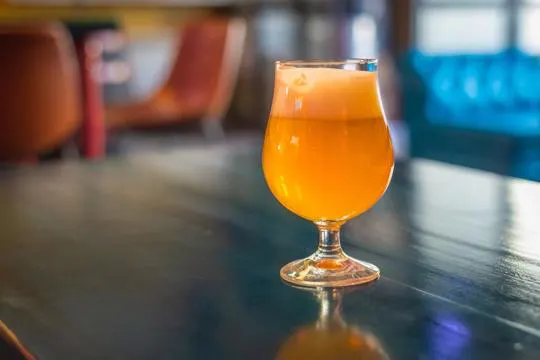Summary of key points
The primary difference between gose and sour beers lies in their ingredients and brewing process. Gose is a specific style of beer that traditionally includes salt and coriander, offering a unique blend of salty, herbal, and slightly sour flavors. Sour beers, on the other hand, encompass a broader category that relies on wild yeast strains or specific bacteria for fermentation, leading to a wide range of sourness levels and flavor profiles.
Ever stood in front of a craft beer section, scratching your head?
It’s like choosing between Netflix or Hulu on a Friday night.
Gose and Sour—the twin mysteries of the beer universe.
We’ve all been there; that moment of indecision.
It’s basically the adult version of choosing between chocolate or vanilla. Tough, right?
Our crew once mixed them up at a party.
Result? A flavor surprise that had us questioning all our life choices.
Now, we’re here to break it down for you. No more beer aisle panic attacks.
We’re tackling the Gose versus Sour conundrum.
Armed with knowledge, you’ll become the beer guru nobody knew they needed.
What is Gose?

Gose is a tart and salty beer from Germany.
It’s brewed with malted barley, wheat, and salt.
Plus, lactic acid is added during fermentation, giving it a tangy flavor.
And, it’s balanced by a hint of saltiness.
Coriander seeds also add an aromatic complexity.
Fruit and herbs like lemon, lime, or cucumber can be added too.
Gose dates back centuries. It was brewed in Goslar, Germany, then became popular in Leipzig.
But, in the 20th century, it almost disappeared. Fortunately, it has been revived lately.
Today, Gose is loved all over the world for its sourness and saltiness.
It’s light and has low alcohol, making it perfect for those looking for a flavorful refreshment.
What is a Sour Beer?

Sour beer is a one-of-a-kind brew, with a tangy taste.
It’s fermented in a unique way, giving it an acidic kick.
Unlike regular beers, sour beer has wild yeast and bacteria added to the brewing process.
This mix creates complex flavors and aromas.
Brewers have to be precise when crafting sour beer.
They pick particular strains of yeast and bacteria for fermentation.
Lactic acid bacteria like Lactobacillus and Pediococcus add tartness.
Wild yeast strains like Brettanomyces offer their own aroma.
Sour beers come in many styles.
Berliner Weisse is German and has a crisp acidity.
Belgium’s Gueuze mixes young and old lambic beers for a tangy taste.
American Wild Ales use fermentation techniques with local ingredients.
Differences Between Gose and Sour Beer

Gose and Sour beers have different origins.
Ingredients
Gose and Sour beers have different ingredients. These ingredients affect the flavor profile.
A traditional Gose has barley, wheat, hops, water, and yeast.
It also has coriander and salt, adding citrusy and spicy notes.
Salt enhances the tanginess, giving it a refreshing taste.
Sour beers use the same base ingredients, but with variations.
They also have bacteria, like lactobacillus or pediococcus.
These interact with the wort and create lactic or acetic acid.
This makes the beer sour. Some brewers add fruit for complex flavors.
In conclusion, Gose and Sour beers have contrasting ingredients. They make unique tastes.
So when choosing, remember these ingredients come together to create your experience.
Brewing Process
Brewing is key for creating the special flavors of gose and sour beers.
It uses both traditional methods and modern innovation.
Brewers pick ingredients, such as malted grains, hops, water, and yeast.
These all affect the final flavor. Also, bacteria are sometimes added to give unique sour notes.
The ingredients go into a mash tun.
Hot water activates something called “enzymes”, which turn starches into sugar.
Then, the sugar is separated from the grain husks. Boiling happens next.
Hops are added to give bitterness and aroma.
Timing and duration of hop addition vary.
The liquid is cooled, then put in a fermentation vessel.
Yeast and bacteria, like lactobacillus or pediococcus, are added to ferment the beer.
Bacteria eat sugars yeast can’t, creating lactic or acetic acid that gives tartness.
Fermentation might take weeks or months.
Afterwards, conditioning or aging can improve taste and clarity.
Flavor Profile and Taste
Gose: Gose is known for its refreshing, tart taste and prominent saltiness.
It has subtle hints of coriander and wheat malt, plus a salty touch.
It’s low in bitterness and offers a mild yet delightful intensity.
Sours: Sours offer a versatile range of flavors, like cherries, berries, pineapples, or mangoes.
They often include other ingredients, like fruits and spices, to boost their complexity.
The acidity in Sours serves as the backbone to their flavor.
Both Gose and Sour provide beer aficionados with unique tasting experiences.
Gose is a harmonious blend of sourness and salinity.
Sours offer bold, daring flavors and endless possibilities for experimentation.
Whatever your preference, these styles provide a tantalizing journey for the taste buds.
Origin and History
Gose and Sour beers have a fascinating history.
Gose is a traditional German brew, stemming from Goslar.
It has been around since the 16th century and is known for its salty, sour flavor.
Coriander and salt are added during the brewing process.
Sour beers have a global past.
For example, Belgian Lambics are produced using wild yeasts and bacteria.
This unique fermentation process gives these beers their tart taste.
Recently, Gose and Sour beers have become popular again among craft beer fans.
Brewers are mixing fruits and other ingredients to create a variety of flavors.
You can find classic styles and experimental ones too.
Gose and Sour beers offer a unique and complex flavor.
Beer enthusiasts everywhere are captivated by them.
Whether you like traditional German Gose or something more daring, these beers will refresh and delight you.
Similarities Between Gose and Sour Beer

Gose and sour beers share similarities.
They have a tangy, acidic flavor from souring agents added during brewing.
Plus, fruit or spices are often used to add complexity.
Both styles usually have low alcohol content, making them refreshing.
However, Gose beers have a subtle salty flavor due to added salt.
Sour beers focus more on tartness from natural fermentation.
So, even though they’re both sour beer styles, Gose and sour beers have distinct traits that appeal to different tastes.
Notable Gose and Sour Beer Varieties
Gose and Sour Beer Varieties offer a diverse range of flavors and brewing techniques.
Each type has its own unique properties.
Gose Beers are famous for their crispness and tartness, with a salty undertone.
They come from Germany, where they’re usually brewed with coriander and sea salt.
Notable types include traditional German Gose from Leipzig, and Westbrook Brewing Company’s Mexican Cake Gose.
Sour Beers, on the other hand, include styles such as Berliner Weisse, Flanders Red Ale, and Lambic.
They get their sourness through fermentation or by adding bacteria like Lactobacillus or Pediococcus.
Their flavors can be mild tanginess, or strong puckering sensations.
Notable examples include Rodenbach Grand Cru, Cantillon Gueuze 100% Lambic Bio, and The Bruery’s Oude Tart.
Gose and sour beers have special flavors that excite beer fans who want something different from hoppy or malty beers.
Gose Beers have a balanced taste with salty hints.
Sour Beers vary in intensity and complexity.
If you’re looking for a unique drinking experience, try Gose and Sour Beer Varieties.
Traditional German Gose has historical charm.
Modern sours have a creative, experimental nature.
This beer shows innovation in the brewing industry, and gives you an unforgettable experience.
When to Choose Gose or Sour Beer
Gose and sour beer have key differences.
Gose is a German style with salty and tart flavors.
Sour beers, on the other hand, have different flavors, like fruity, funky, or intensely sour.
Gose has salt to give it a savory taste.
It’s also balanced with citrus or fruit, making it a great light beer option.
Sour beers, on the other hand, are more acidic and can have fruity, earthy, or vinegary notes.
Gose is milder and less acidic while sour beer is bolder.
So, if you want a refreshing beer, gose is the way to go.
For an adventurous flavor experience, try a sour beer.
Conclusion
To conclude, gose and sour beers are beer styles with some clear defining characteristics.
Gose is an old-world beer brewed with coriander, salt, and spontaneous fermentation.
While many sour beers use the same methods, new iterations of brews have added other fruits or herbs to create new flavor profiles.
Both styles provide tasty refreshment at a slightly lower ABV than their traditional counterparts, lending them even greater appeal to those looking to enjoy the taste of beer without all the associated issues of high alcohol consumption.
Despite being different in terms of flavor, both styles offer something for everyone: tart and sweet concoctions that can still be enjoyed on a hot summer day as well as during cold winter months around a crackling fire.
As brewers continue experimenting with these two popular styles, it will be interesting to see what unique flavors they come up with next.
